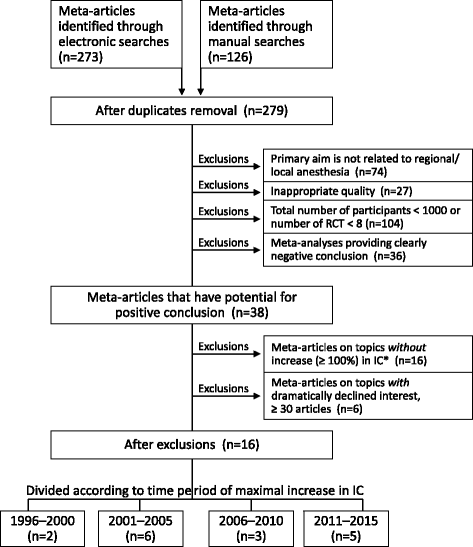Assessing advances in regional anesthesia by their portrayals in meta-analyses: an alternative view on recent progress
- PMID: 28851295
- PMCID: PMC5576355
- DOI: 10.1186/s12871-017-0406-3
Assessing advances in regional anesthesia by their portrayals in meta-analyses: an alternative view on recent progress
Abstract
Background: The aim of this study was to delineate research reflecting advances in regional/local anesthesia where recent clinical progress was clearly defined by meta-analysis.
Methods: We conducted a search to identify all articles with meta-analyses of randomized clinical trials related to the field of regional/local anesthesia. From 279 titles, after multiple exclusions, 16 meta-analyses on important clinical practice developments with high potential for a positive conclusion on the effectiveness of the treatment were left for the assessment. The assessment was performed in two steps. The first step was related to verification of proof-of-concept: the effect is statistically reliable (p-value, effect size, heterogeneity across different RCTs) and the risk of bias not too high. The second step was devoted to attempts to form an opinion on the real clinical benefits of a new development.
Results: The assessment revealed that seven recent developments passed the proof-of-concept step. At the same time, positive conclusion on real clinical benefits was reached only by one of these seven developments: ultrasound guidance for peripheral nerve blocks (at least with some of the blocks). Meaningful clinical improvements with other developments remains uncertain. The assessment of the relationships between analyzed advancements over the past 30 years and earlier similar developments indicated that their evolution was usually incremental. The most original advancement was found to be the introduction of the transversus abdominis plane block.
Conclusion: The assessment of recent advances in regional/local anesthesia, based on the evaluation of related meta-analyses, revealed only incremental progress with mostly marginal benefits. The progress was the most notable with ultrasound guidance for some of peripheral nerve blocks.
Keywords: Epidural anesthesia; Minimal clinically important difference; Nerve blocks; Real-world evidence; Spinal anesthesia.
Conflict of interest statement
Ethics approval and consent to participate
Not applicable.
Consent for publication
Not applicable.
Availability of data and materials.
Presented within the manuscript.
Competing interests
There are no financial or non-financial competing interests.
Publisher’s Note
Springer Nature remains neutral with regard to jurisdictional claims in published maps and institutional affiliations.
Figures
Similar articles
-
The Analgesic Efficacy of Ultrasound-Guided Transversus Abdominis Plane Block in Adult Patients: A Meta-Analysis.Anesth Analg. 2015 Dec;121(6):1640-54. doi: 10.1213/ANE.0000000000000967. Anesth Analg. 2015. PMID: 26397443
-
Is ultrasound guidance advantageous for interventional pain management? A review of acute pain outcomes.Anesth Analg. 2011 Sep;113(3):596-604. doi: 10.1213/ANE.0b013e3182223397. Epub 2011 Jun 3. Anesth Analg. 2011. PMID: 21642604 Review.
-
Ultrasound-Guided Ankle Blocks: A Review of Current Practices.AANA J. 2015 Oct;83(5):357-64. AANA J. 2015. PMID: 26638458 Review.
-
Practical pediatric regional anesthesia.Curr Opin Anaesthesiol. 2013 Jun;26(3):327-32. doi: 10.1097/ACO.0b013e3283606a1e. Curr Opin Anaesthesiol. 2013. PMID: 23614955 Review.
-
Ultrasound-guided ophthalmic regional anesthesia.Curr Opin Anaesthesiol. 2016 Dec;29(6):655-661. doi: 10.1097/ACO.0000000000000393. Curr Opin Anaesthesiol. 2016. PMID: 27652513 Review.
References
-
- Walsh M, Srinathan SK, McAuley DF, Mrkobrada M, Levine O, Ribic C, Molnar AO, Dattani ND, Burke A, Guyatt G, Thabane L, Walter SD, Pogue J, Devereaux PJ. The statistical significance of randomized controlled trial results is frequently fragile: a case for a fragility index. J Clin Epidemiol. 2014;67:622–688. doi: 10.1016/j.jclinepi.2013.10.019. - DOI - PubMed
Publication types
MeSH terms
LinkOut - more resources
Full Text Sources
Other Literature Sources
Miscellaneous


